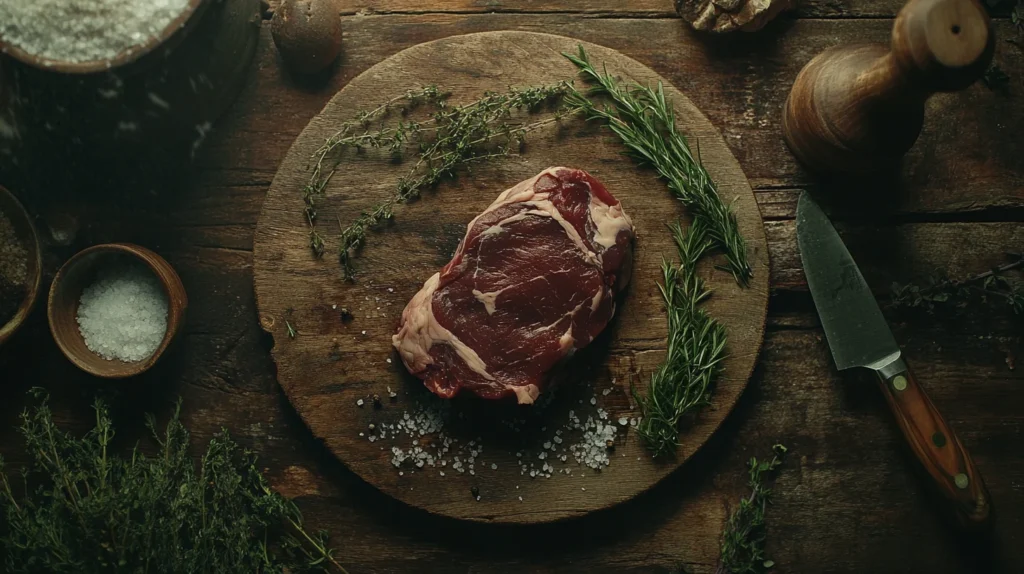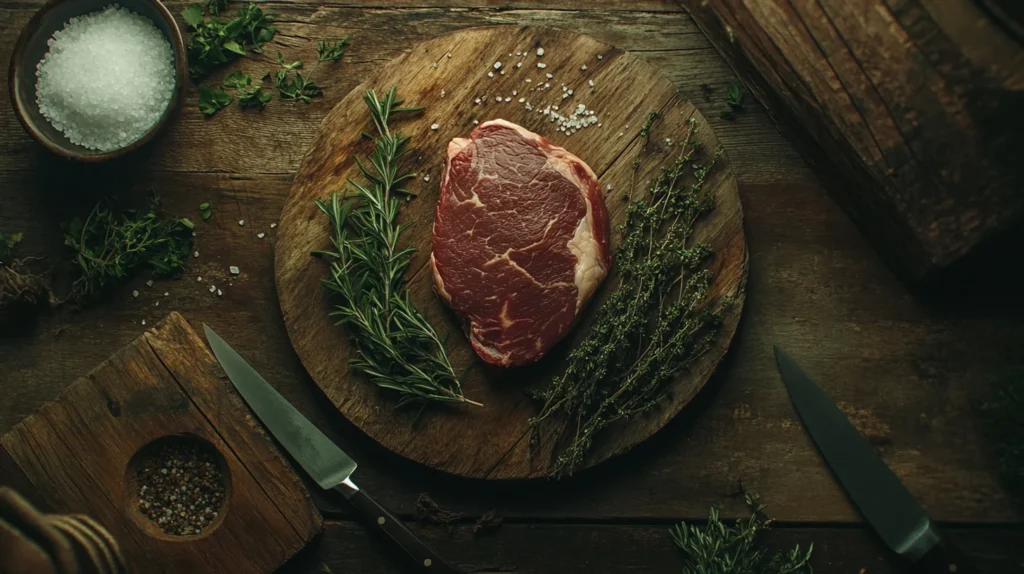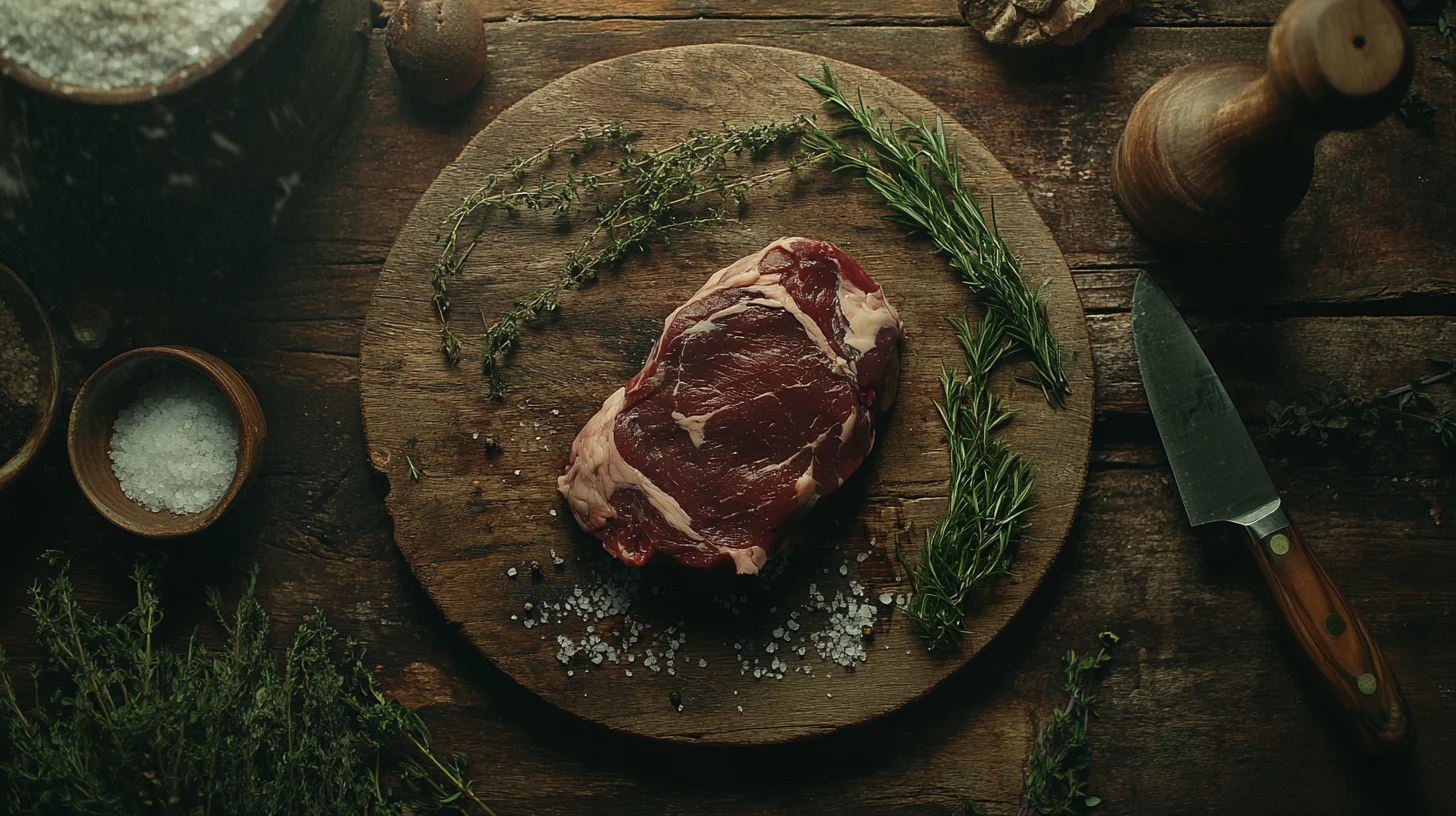As a seasoned hunter, I know the thrill of a successful hunt. But the real challenge is in the kitchen. Preparing deer meat, or venison, is a delicate dance. It balances food safety with mouthwatering flavors.
If you’re like me, you’ve probably wondered, “Do You Rinse Deer Meat Before Cooking?” This guide will walk you through the essential steps. You’ll learn how to make your venison dishes safe and truly exceptional.
Related : Deer Meat Cube Steak Recipe for Your Next Meal

Key Takeaways
- Understand the different cuts of venison and their unique characteristics
- Learn proper storage and handling techniques to prevent cross-contamination
- Discover the truth behind common myths about washing game meat
- Explore the best methods for cleaning and preparing deer meat for cooking
- Uncover the secrets to enhancing the flavor of your venison dishes
Understanding Deer Meat: From Field to Kitchen
Deer meat, or venison, is a versatile and nutritious protein. It has been a staple in many households for generations. Whether you’re an avid hunter or a health-conscious consumer, understanding venison is key to your culinary adventures.
This section will give you the knowledge to navigate the world of venison with confidence. You’ll learn about the different cuts of deer meat and how to spot freshness.
Understanding Deer Meat: From Field to Kitchen
Venison, the meat from wild deer, is a favorite among food lovers. To enjoy it fully, knowing the different cuts and their qualities is important. Also, knowing how to spot fresh and quality deer meat can make your cooking better.
Different Cuts of Venison and Their Characteristics
Venison comes in many cuts, each with its own taste and texture. From the tender loin to the flavorful shoulder, each needs special cooking to shine. Learning about these cuts helps you choose the right venison for your dish.
Quality Indicators in Fresh Deer Meat
When handling venison, knowing its quality is key. Good venison is bright red, firm, and has a mild smell. By recognizing these signs, you can pick the best venison for your meals.
| Quality Indicator | Desirable Characteristic |
|---|---|
| Color | Deep, rich red |
| Texture | Firm, yet tender |
| Aroma | Mild, earthy scent |

“Handling and preparing venison with care is the key to unlocking its true potential as a culinary delight.”
Do You Rinse Deer Meat Before Cooking?
Preparing venison raises a common question: should you rinse deer meat before cooking? This debate is especially true for game meat lovers. Let’s look at the reasons for and against rinsing venison. We’ll also find out the best ways to keep your food safe and tasty.
Some people rinse deer meat to remove impurities and blood. Others worry it might lose its natural juices and flavor. It’s a choice that depends on personal preference and food safety.
Experts say rinsing raw meat is generally not recommended. Rinsing can spread harmful bacteria like Salmonella or E. coli. Instead, focus on keeping your kitchen clean and sanitized.
| Pros of Rinsing Deer Meat | Cons of Rinsing Deer Meat |
|---|---|
| May help remove blood and impurities Can improve appearance and texture | Increases risk of cross-contamination Can result in loss of natural juices and flavor Unnecessary if meat is properly cleaned and trimmed |
Most food safety experts and chefs agree: rinsing deer meat is generally not necessary or recommended. Instead, focus on proper handling, cleaning, and cooking techniques. This ensures your venison dishes are safe and delicious.
Essential Safety Precautions for Handling Raw Venison
Handling and storing raw venison safely is key to avoid foodborne illnesses. Hunters and home cooks need to know the basics of wild game food safety and venison handling methods.
Proper Storage Temperature Guidelines
Deer meat, or venison, spoils quickly and needs to be stored at the right temperature. After field dressing, put the meat in the fridge or freezer fast. Keep it below 40°F (4°C) to stop bacteria from growing too much.
Cross-contamination Prevention Methods
- Keep raw venison away from other foods to avoid contamination.
- Use separate cutting boards, knives, and utensils for venison. Clean them well before using with other foods.
- Wash your hands with soap and water before and after touching raw venison.
Workspace Sanitization Requirements
Keep your workspace clean and sanitized when working with venison. Wipe down surfaces like countertops and sinks with a disinfectant often. This helps get rid of bacteria and pathogens.
By sticking to these safety steps, you can keep your wild game food safety practices safe. This reduces the chance of getting sick from raw venison.
Common Misconceptions About Washing Game Meat
Preparing deer meat or other game meat comes with some common myths. It’s key to know the truth for good game meat hygiene and to stay safe from food safety issues.
Many think washing game meat gets rid of all bacteria. But, this isn’t always true. Rinsing can spread bacteria, causing cross-contamination. The best way is to handle, store, and cook the meat right to kill harmful germs.
Some believe rinsing makes meat cleaner. But, it doesn’t change the bacteria inside. Good deer meat preparation means cleaning, trimming, and cooking it well to keep it safe.
“Rinsing meat can actually spread any existing bacteria, potentially leading to cross-contamination.”
Traditional methods like soaking meat in saltwater or vinegar are not needed. They don’t kill bacteria and can change the meat’s taste and texture.
The main thing for game meat hygiene is to handle, store, and cook it right. Don’t think rinsing or washing makes it safer to eat.
Proper Cleaning Methods for Fresh Venison
Cleaning and preparing fresh venison is key in the wild game culinary experience. The right handling and cleaning can boost the flavor, texture, and quality of your deer meat. Let’s explore the essential steps to make sure your venison is ready for a tasty and safe meal.
Removing Blood and Debris
After field-dressing the deer, rinse the venison under cold running water. This step removes any blood, dirt, or debris from the hunting and dressing process. Be gentle but thorough, making sure to clean all surfaces of the meat.
Trimming Fat and Silver Skin
Venison is naturally lean but might have excess fat and silver skin. Use a sharp knife to carefully trim away any visible fat and silver skin. This improves the meat’s texture and mouthfeel, and also reduces off-flavors during cooking.
| Venison Handling Method | Benefit |
|---|---|
| Rinsing under cold water | Removes blood, dirt, and debris |
| Trimming fat and silver skin | Enhances texture and flavor |
By following these proper venison handling methods, you can ensure your wild game culinary techniques result in a delicious and high-quality dining experience. Remember, attention to detail in the preparation stage can make all the difference when it comes to enjoying the unique flavors of venison.
Signs of Spoilage in Deer Meat
Knowing how to spot spoiled deer meat is key for safe venison cooking. Spoiled meat can be harmful, so it’s vital to recognize the signs before cooking.
Here are some key indicators that your deer meat may have gone bad:
- Discoloration – Look for any changes in color, such as a greenish or grayish tint, which can signal the presence of bacteria.
- Unpleasant Odor – Spoiled venison will have a distinct, sour or rancid smell that’s quite different from the fresh, earthy aroma of properly stored meat.
- Sticky or Slimy Texture – Deer meat that has a tacky, sticky, or slimy feel is likely no longer fresh and should be discarded.
- Mold Growth – Any visible mold on the surface of the meat is a clear sign that it has spoiled and is unsafe to eat.
If you notice any of these signs, it’s best to throw the meat away. Eating spoiled venison can cause serious health issues. Always follow safe wild game food safety practices for delicious and healthy venison cooking tips.
Pre-cooking Preparation Techniques
Before enjoying the rich, buttery taste of venison, you must prepare the deer meat right. Marinating and using dry rubs are key steps. They can turn even the toughest deer meat into tender, delicious dishes.
Marinating Methods for Tenderness
Marinating is great for making venison tender. Acidic parts in marinades break down the meat’s tough fibers. This makes the meat tender and full of flavor. Try marinating your venison in olive oil, vinegar, herbs, and spices for 2-4 hours, or up to 24 hours for the best taste.
Dry Rub Applications
Applying a dry rub can also improve deer meat’s flavor and texture. A good dry rub adds a tasty crust and deepens the meat’s flavor. Mix brown sugar, paprika, garlic powder, onion powder, and herbs and spices to create your rub.
- Coat the deer meat evenly with the dry rub, ensuring full coverage.
- Let the rub sit on the meat for at least 30 minutes before cooking, or up to 12 hours for maximum flavor absorption.
Mastering these pre-cooking techniques will help you get the most out of your venison. You’ll create a memorable dining experience that will have your guests wanting more.
Best Practices for Aging Venison
Aging venison is key to improving its taste and tenderness. It’s a vital part of wild game culinary techniques. By mastering the right venison handling methods, you can bring out the best in this special meat.
There are two main aging methods: wet and dry. Wet aging keeps the meat in its juices or a vacuum-sealed bag. This method tenderizes the meat naturally. Dry aging, however, exposes the meat to controlled conditions. This concentrates flavors and improves texture.
- Wet aging: 7-14 days
- Dry aging: 14-28 days
Proper storage is essential for aging. Keep the temperature between 34-38°F and humidity at 60-80%. Make sure the meat is elevated and well-ventilated to avoid spoilage.
“Aging venison is an essential step in creating a truly remarkable culinary experience. With the right techniques, you can transform this wild game into a mouthwatering delicacy.”
By using these wild game culinary techniques and venison handling methods, you can make your venison dishes even better. They will be more flavorful and tender.
Temperature and Cooking Guidelines
Getting venison right is crucial for its rich flavors. Cooking wild game like deer meat needs the right temperatures and methods. Follow these tips to cook venison perfectly every time.
Recommended Internal Temperatures for Venison
- Rare: 130°F (54°C)
- Medium-rare: 135°F (57°C)
- Medium: 140°F (60°C)
- Medium-well: 145°F (63°C)
- Well-done: 160°F (71°C)
Use a meat thermometer to check the venison doneness. Avoid overcooking to keep it tender and juicy. A slightly lower temperature is better for a tender texture.
Cooking Methods for Different Venison Cuts
| Venison Cut | Best Cooking Method |
|---|---|
| Tenderloin | Grilling, Searing, Roasting |
| Loin | Grilling, Searing, Roasting |
| Shoulder/Chuck | Braising, Slow Cooking |
| Shanks | Braising, Stewing |
Choose the right cooking method for each venison cut. Tender cuts like tenderloin and loin do well with grilling or searing. But tougher cuts like shoulder and shanks need moist-heat methods like braising.
Knowing the right temperatures and cooking methods unlocks venison‘s full flavor. This way, you can impress everyone with your wild game culinary techniques.
Storage and Preservation Methods
Proper handling and storage of venison are key for food safety and quality. Whether you’re a seasoned hunter or a home cook, knowing the best practices for wild game food safety is important. It helps keep your deer meat fresh and prevents foodborne illnesses.
Freezing is a great way to preserve venison. To keep it fresh, package the meat right. Use vacuum-sealed bags or airtight containers to keep air out and prevent freezer burn. When frozen well, venison stays good for up to 12 months.
Thawing frozen venison needs careful thought too. The safest way is to thaw it in the fridge over 24-48 hours. Never thaw meat at room temperature, as it can grow harmful bacteria.
Proper Freezing and Thawing Techniques
- Vacuum seal or pack venison in airtight containers to prevent freezer burn
- Freeze meat at 0°F (-18°C) or lower for up to 12 months
- Thaw venison in the refrigerator for 24-48 hours, never at room temperature
By sticking to these venison handling methods and wild game food safety rules, your venison will stay fresh, tasty, and safe to eat for a long time after the hunt.
Flavor Enhancement Techniques
Unlocking the full potential of deer meat is all about flavor enhancement. The right seasonings and marinades can make even the leanest cuts of venison taste amazing. This turns a simple meal into a memorable dining experience.
Seasoning Recommendations
Venison’s natural flavors pair well with aromatic spices. Try making your own seasoning blend with:
- Coarse sea salt
- Freshly ground black pepper
- Garlic powder
- Onion powder
- Dried thyme
- Smoked paprika
- Ground juniper berries (optional)
Use this seasoning to coat your venison before cooking. It helps lock in moisture and brings out the natural flavors.
Marinade Recipes
Marinating your venison can add even more flavor. A classic red wine marinade tenderizes the meat and adds a rich taste. Mix together:
- Dry red wine
- Olive oil
- Balsamic vinegar
- Minced garlic
- Chopped fresh rosemary
- Black peppercorns
Let the venison marinate for a few hours or up to 24 hours. This makes the meat tender and full of flavor.
Mastering these tips will help you create delicious meals with deer meat. Your dishes will be flavorful and unforgettable.
Conclusion
Preparing and cooking deer meat, or venison, right is key for a great meal. Knowing how to handle and cook different cuts makes a big difference. This way, you can make your deer meat dishes even better.
We’ve covered a lot in this guide, from the start to the kitchen. You now know how to spot good venison and how to clean and age it. Always keep food safety in mind, especially when storing and handling meat.
Start exploring different flavors and cooking ways with your venison. Try grilling, roasting, or searing to see what you like best. Remember, the right method depends on the cut and how you like it cooked. Enjoy the unique taste of deer meat and impress everyone with your dishes.
FAQ
Do you need to rinse deer meat before cooking?
Whether to rinse deer meat before cooking is a debate. Some say it removes blood and debris. Others warn it might spread harmful bacteria. The best way is to clean and trim the meat well, then cook it safely.
How should you prepare deer meat for cooking?
Preparing deer meat involves a few steps. First, check for blood clots, bones, or debris and remove them. Then, trim off excess fat and silver skin to improve texture and taste. Always keep your work area clean and wash your hands and tools well.
What are the best cooking methods for venison?
Venison is best cooked to keep it tender and moist. Grilling, pan-searing, braising, and slow-cooking are good methods. Cook it to 145°F for medium-rare or 160°F for medium. Let it rest for a few minutes before slicing to keep the juices in.
How do you store and preserve deer meat?
Storing deer meat right is key to its quality and safety. Keep fresh venison in the fridge at 40°F or below for 3-5 days. For longer storage, freeze it at 0°F or below. Use vacuum sealing or airtight bags to prevent freezer burn. Thaw it in the fridge, not at room temperature, to avoid bacterial growth.
What are some tips for enhancing the flavor of venison?
There are many ways to make venison taste better. Marinate it in wine, vinegar, or citrus to tenderize and flavor it. Dry rubs with spices and herbs also boost its taste. Slow-cooking methods like braising or stewing add deep, rich flavors.

